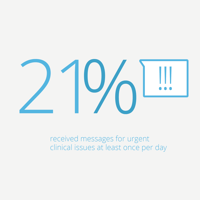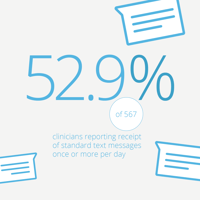A national survey of hospital-based clinicians found that close to 80% of clinicians still rely on pagers for communication and that few hospitals have succeeded in introducing secure text messaging as a primary channel for care-related communication. In fact, 53% of clinicians indicate standard text messaging (not secure) was common, despite the fact that 22% of these messages are sent with individually identifiable information in violation of HIPAA compliance requirements.
The Cost of Pagers Continues to Rise
A recent study published in the Journal of Hospital Medicine, “Hospital-based clinicians’ use of technology for patient care-related communication,” found that 49% of clinicians see pagers as the most common communication method for patient care-related messages. To many physician, the pager is nearly a ‘right of passage,’ a part of becoming a physician.
 Despite their dominance, pagers come with many downsides for clinical efficiency and hospital costs. Physicians often juggle several pager devices, with unreturned messages and one-way workflows causing communication delays or errors. One study found that 14% of pages were sent to the wrong physician, half of those being “urgent” or “emergency.”
Despite their dominance, pagers come with many downsides for clinical efficiency and hospital costs. Physicians often juggle several pager devices, with unreturned messages and one-way workflows causing communication delays or errors. One study found that 14% of pages were sent to the wrong physician, half of those being “urgent” or “emergency.”
The average nurse spends 56% of their time on care co-ordination and documentation, including time wasted looking up pager numbers and waiting for call-backs. In the event a page is unanswered, a nurse must repeat the process for the next physician. With increased pressures on clinicians and nurses to update messages to an EMR for audibility, and the desire for in-depth and real-time communication about patient status, pagers have resulted in many communication breakdowns that contribute to the $12 billion annual cost to US hospitals for communication inefficiencies.
Despite increasing costs, pagers remain ingrained in the workflow of physicians and are connected to many hospital systems and processes; many hospitals have struggled with evaluating, implementing and rolling out a pager alternative.
Why Standalone Communication Solutions Fail
In the recent study, 27% of clinicians report that their organization had implemented a secure messaging application that is in use by some, but only 7% report secure text messaging applications as being used by most clinicians. This data indicates that hospitals have failed to shift away from pager culture even when more secure text message applications are introduced.
 Our own conversations with hospitals and medical groups has revealed that physicians and care givers often turned to standard text messaging to improve clinical communication. Despite the potential HIPAA violations of the practice, standalone secure text messaging solutions often fail to improve clinical workflow or offer an improvement to other problems in clinical communications. Without a noticeable improvement over standard text messaging, these standalone solutions often fail.
Our own conversations with hospitals and medical groups has revealed that physicians and care givers often turned to standard text messaging to improve clinical communication. Despite the potential HIPAA violations of the practice, standalone secure text messaging solutions often fail to improve clinical workflow or offer an improvement to other problems in clinical communications. Without a noticeable improvement over standard text messaging, these standalone solutions often fail.
5 Tips to Shift Your Pager Culture
Most hospitals maintain 10-12 different communication systems, including legacy systems such as pagers and DTEC phones. Rather than add to the complexity with a new technology, you can solve the critical flaws in communication workflows through integration and a respect for existing pager processes and cultural practices.
Hospitals that have succeeded in transitioning away from pager culture when they:
- Make the transition slowly by allowing physicians to retain their pager number while ditching the pager device. Existing pager workflows can remain while adding in the benefit of two-way communication (text or voice) to instantly improve communication and care co-ordination. Message or call directly from a personal smartphone while keeping the number secure and private.
- Include all members of the care team in deploying technology since pager workflow affects not only physicians but also nurses, lab techs and others who interact with the physician. Improve communication speed by creating automatic workflow rules that route messages to the right person or group based on their on-call availability or status.
- Provide a unified communication solution to drive all communication through one platform, unifying 10+ communication systems into a single interface while providing reliability. Ensure priority message delivery even when a smartphone loses its data connection along with persistent delivery features to retry primary and secondary phone and email options, with automatic escalation in case of non-response.
- Provide value through integrations with other clinical systems such as the EHR, nurse call and lab systems to visualize messages specific to a patient, diagnostic notes, care team information and a patient roster in real time. These integrations solve critical pain points in clinical workflow, reducing the need to log into multiple systems and providing medical professionals a breadth of information needed for proper patient care.
- Have a technology leader who will champion the use of the new communication technology. After the application is installed, users need to see it in action, with leaders pulling people into message threads and demonstrating the flow of information. In early stages of use, technology leaders provide valuable training and ensure team customizations are communicated effectively.
Telmediq’s Healthcare Communications Hub (HCH) integrates with your hospital’s clinical, IT, and telecom systems to unify communications and streamline care coordination. The ultimate result of quick and error-free communication is improved patient experience and safety as well as savings for your clinicians and supporting staff.
Evolve your healthcare communication system by respecting the unique healthcare processes and professionals in your organization. Learn more about the benefits of a full Healthcare Communications Hub.


